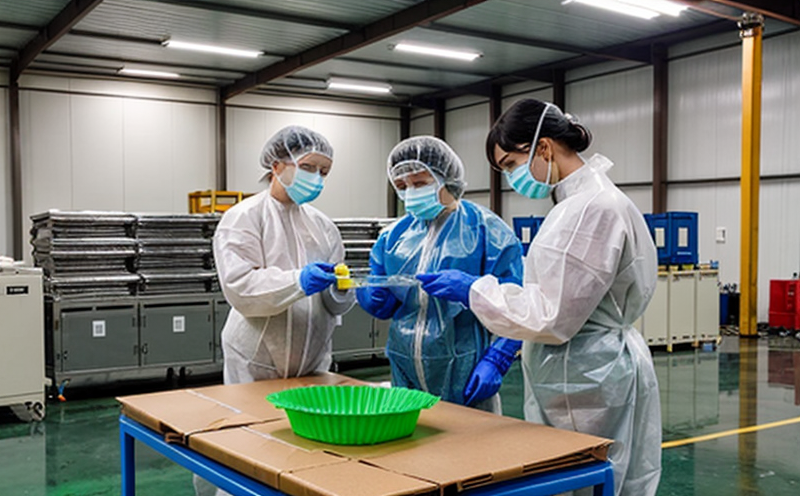ISO 75-3 Heat Deflection of Molded Plastics
The ISO 75-3 test standard is a critical procedure used to determine the heat deflection temperature (HDT) of molded plastics. This property provides valuable information about how materials will behave under thermal stress, which is essential for ensuring product durability and safety in various applications.
During this testing process, specimens are subjected to a specified load at their midsection while being heated incrementally until they deform to a preset angle or distance. The temperature at which deformation occurs indicates the material's heat deflection point. This value helps manufacturers and engineers assess whether plastic components will remain stable under expected operating conditions.
The ISO 75-3 method is widely recognized for its precision and repeatability, making it a preferred choice across industries where reliable data on thermal performance is crucial. The test can be particularly useful in sectors like automotive, electronics, and consumer goods, where components must withstand high temperatures without failure.
The ISO 75-3 procedure involves several key steps that ensure accurate measurement of heat deflection temperature:
- Specimen Preparation: Specimens are typically cut from larger parts and trimmed to the specified dimensions. Careful preparation ensures consistent results.
- Loading: The specimens are placed in a test fixture with a uniform load applied at their midsection. This load simulates real-world stress conditions that plastic components might encounter.
- Heating and Observation: The specimens are heated gradually while being monitored for deflection using precision measurement tools. The temperature is recorded as the point where deformation reaches the specified threshold.
The test results provide a clear indication of a material's thermal stability, which is vital in selecting appropriate materials for high-temperature applications. For instance, in automotive interiors, understanding HDT can help prevent issues like seat cushions or headrests melting during extreme weather conditions.
In the electronics sector, where devices often operate near their maximum temperature limits, knowing the heat deflection point of plastic components ensures that connectors and enclosures do not deform or fail under normal use. This information is also crucial for compliance with international safety standards such as IEC 60950-1.
The ISO 75-3 test offers a standardized approach to evaluating the thermal performance of molded plastics, which is essential for quality assurance and regulatory compliance. By adhering to this method, laboratories can provide consistent, reliable data that supports informed decision-making in product development and manufacturing processes.
Benefits
The ISO 75-3 heat deflection test offers numerous advantages for manufacturers and quality assurance teams:
- Enhanced Product Durability: Understanding the HDT of plastic materials helps in selecting components that can withstand high temperatures without deforming.
- Avoidance of Failures: By identifying potential weak points early, manufacturers can prevent costly recalls and product failures.
- Compliance Assurance: The test ensures that products meet industry standards like ISO 75-3 and other relevant regulations.
- Improved Product Design: Data from this test aids in optimizing design parameters, leading to more efficient and reliable product designs.
The results of the ISO 75-3 test are critical for ensuring that plastic components perform reliably under thermal stress. This is particularly important in industries where safety and performance are paramount, such as automotive and aerospace.
Why Choose This Test
- Precision and Consistency: The ISO 75-3 method is known for its high precision and consistent results, making it a reliable choice.
- Industry Standard: It is widely accepted by industry professionals, ensuring that test results are valid across different markets.
- Repeatability: The standardized procedure ensures that the same results can be achieved consistently in multiple laboratories.
- Comprehensive Data: The test provides a complete picture of how plastic materials behave under thermal stress, offering valuable insights for product development.
Choosing the ISO 75-3 heat deflection test ensures that manufacturers and quality assurance teams have access to accurate data that can drive informed decisions. This test is particularly beneficial in industries where product reliability and safety are critical.
International Acceptance and Recognition
- Global Consistency: The ISO 75-3 standard ensures that the test results are consistent across different countries, facilitating easier international trade.
- Regulatory Compliance: Adherence to this standard helps manufacturers comply with various national and international regulations.
- Market Trustworthiness: The use of internationally recognized standards enhances the trustworthiness of products in global markets.
The ISO 75-3 heat deflection test is widely accepted by regulatory bodies and industry leaders. Its international recognition ensures that manufacturers can confidently meet global market demands. This standard plays a crucial role in ensuring that plastic components perform reliably under thermal stress, which is essential for compliance with international standards like IEC 60950-1.





